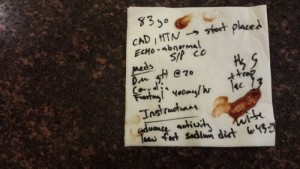
SALT LAKE CITY, UT – An 83-year-old man was transferred to the University Hospital Critical Care Unit from an outside hospital on Tuesday, with a small napkin describing relevant aspects of his 14-day course.

The ICU transfer, who arrived intubated, on ECMO, an intra-aortic balloon pump in place, and with a blood pressure of 56/39, reportedly has a past medical history notable only for “CAD, HTN.” Also mentioned in the highly-detailed document were the results of his recent cath, which were apparently “stent placed,” and his echocardiogram, which was reportedly “abnormal.”
Fortunately, the outside hospital did include a list of active medications, including “gtt @ 20” and “?Coumadin.”
Pertinent lab values were also listed, notable for hemoglobin of either a 5 or 9, as well as a troponin of “+.” An undated EKG, sketched on the back of the napkin, appears to show some sort of QRS complex.
Based on the large, recent surgical scar and wound VAC on his abdomen, the admitting team was able to deduce that “s/p co” may indicate the patient had a colectomy of some variety, for some indication.
The lone word “kidney” was written at the bottom, suggesting that the patient may have renal dysfunction, or perhaps was included simply to indicate that he has one or more kidneys.
Given his tenuous status, as may be indicated by what is either “lact 13” or “lact 1.3,” depending if the dot was BBQ sauce or ink. The napkin also thoughtfully includes emergency contact info for his next of kin: “wife,” followed by a six-digit telephone number running off the napkin.
In addition to the this comprehensive hospital course were discharge instructions for the soon-to-be deceased man. Written within the restaurant’s logo one can make out recommendations such as “advance activity as tolerated,” eat a “low-fat, sodium-controlled diet,” and “take all medications as directed” (presumably referring to fentanyl drip at 400 mcg/hour).
Also included was a 12-page document prepared by the paramedics during the 45-minute drive, including q5min vital signs, detailed drip titrations, ventilator settings, and a detailed physical exam.
Haha!!!
#zerowaste
lmao ! Love it
Perfect! Instead penises with medical information, be practical with your practical jokes
Hahaha! Yep! That should get you started. Just pretend you are in the ED.
That’s really cool and weird mostly weird
This is really quite common. Such a bonus on the correct form. But reusing a paper napkin counts as recycle.
I have seen these things written on the sheets also
Omg, Sharon
Ok, I’m a layperson here, but why didn’t they sharpie all of that right on the patients face? No napkin to lose.
Yep, love my paper towels!
Oh man we hate it when they send this crap in a medical record LOL
Thank goodness they did not send the nurse’s scrub pants with all the vitals written on it.
BBQ sauce
I hope that’s ketchup!!!!
?coumadin…lol
?coumadin…lol
That’s what the fitted sheets are for! Just write the report beside their head! Duh!
My stationary of choice !!
Is that poop or chocolate?
Most complete.
Most complete.
I’m thinkin’, is there a problem?
Lol! That really is high class! I always used paper towels or in hospital scrubs ink on the thigh of scrub pants worked in a pinch!
This is better than some reports I’ve received from an outside hospital lol.
Mary Jo Gover
Well yeah?
Mary Jo Gover
Well yeah?
Usually we just get the patient, napkin is a bonus
I do my best work om paper towels
Wow!
I’ve had vent settings to mini reports on pillowcases.
That’s gotta be the worst ever
Wow this is hilarious
Treatments given include: “fluid, shock, vent, antibiotic & s/p abd surgery”. Accepting physician: Dr. Doomed
I’ve done it. 2 GI bleeders. 3 chest pains and no paper. Whatever works.
At least they didn’t lose the napkin. Makes for a bad day when your paper towel gets thrown out!
Danielle
Katie, I’m dying!
We once received a post CPR transfer from another facility whose entire CPR record was written on “nursing stationary” ( a paper towel.) As you can imagine, HIM, medical record, and legal document jokes dominated the rest of our shift.
That’s more of a report than I’ve gotten on some pts.
That looks like my handwriting…
I like a piece of tape down the scrub pant leg as a nursing turnover report in the OR
What else do you need to know?
Very like the UCF: paper towel, everyone’s universal chart form.
WTF???????
Sounds normal to me.
hahahahaha
What’s the problem, sounds like a typical Epic EHR report. HIEs be damned.
Discharge Instructions for the soon to be deceased man…
It’s like a real life Pop quiz. With someone’s actual Pop.
Anything helps.
Holy smokes haha!!
A step down from the pillowcase…
clearly written by a PGY3 #Onlytheimprotantstuff
I remember this patient.
This!